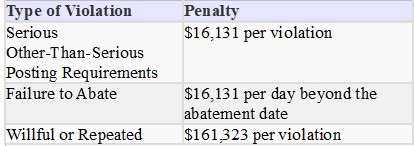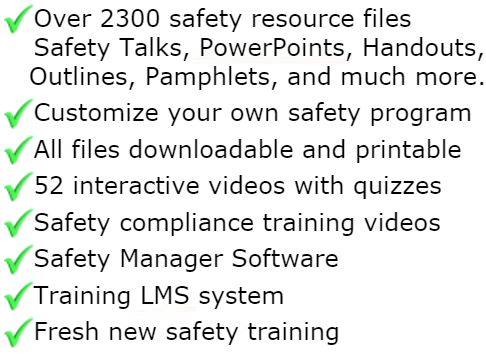
Job Safety Analysis - JSA
Job Hazard Analysis - JHA
Job Safety Analysis (JSA’s) is a process of determining physical requirements, environmental conditions and safety factors relating to a specific job or task. JSA’s are best used for stationary or repetitive production tasks or product movement, in which the job, equipment and work environment change very little.
A job hazard analysis is a technique that focuses on job tasks as a way to identify hazards before they occur. It focuses on the relationship between the worker, the task, the tools, and the work environment. Ideally, after you identify uncontrolled hazards, you will take steps to eliminate or reduce them to an acceptable risk level.
Also See: Ergonomics Section
What is the value of a job hazard analysis?
Supervisors can use the findings of a job hazard analysis to eliminate and prevent hazards in their workplaces. This is likely to result in fewer worker injuries and illnesses; safer, more effective work methods; reduced workers' compensation costs; and increased worker productivity. The analysis also can be a valuable tool for training new employees in the steps required to perform their jobs safely.
For a job hazard analysis to be effective, management must demonstrate its commitment to safety and health and follow through to correct any uncontrolled hazards identified. Otherwise, management will lose credibility and employees may hesitate to go to management when dangerous conditions threaten them.
What jobs are appropriate for a job safety / hazard analysis?
A job hazard analysis can be conducted on many jobs in your workplace. Priority should go to the following types of jobs:
Jobs with the highest injury or illness rates;
Jobs with the potential to cause severe or disabling injuries or illness, even if there is no history of previous accidents;
Jobs in which one simple human error could lead to a severe accident or injury;
Jobs that are new to your operation or have undergone changes in processes and procedures; and
Jobs complex enough to require written instructions.
Job Safety Analysis or JSA is simply a procedure used to review job methods and uncover hazards that may have been overlooked in the layout of the plant or building and in the design of the machinery, equipment, tools, work stations and processes, or that may have developed after production started, or that resulted from changes in work procedures or personnel. It's one of the first steps in hazard and accident analysis and in safety training.
It's really simple. Once the hazards are known, the proper solutions can be developed. Some solutions may be physical changes that eliminate or control the hazard, such as placing a safeguard over exposed moving machine parts. Others may be job procedures that eliminate or minimize the hazard.
Most of the information needed for a Job Saety Analysis, such as environmental conditions, physical requirements and required personal protective equipment is very easy to determine. The more difficult part is listing the steps for a particular task and identifying the necessary safety steps. A Job Safety Analysis is not difficult to perform. You can make up your own form, for your specific equipment, processes or machinery.
Job Safety Analysis Worksheet.
Use this information to actually create a Job Safety Analysis Training Guide, for training employees.
The Job Safety Analysis Worksheet guide is the result of analyzing each specific job in your organization, so when it comes time for training, all the information relating to the job and the safe method of completing the job is documented. This training guide can serve as a checklist for documentation of the training. It can be completed by the person conducting the training, or the individual's supervisor, to ensure all safety aspects, potential hazards and recommended safe job procedures are explained to the individual being trained.
Many companies fail to use Job Safety Analysis because it takes time and effort to analyze each specific piece of equipment and job. The truth of the matter is, it's more cost effective to perform Job Safety Analysis because it saves time, money and certainly reduces accidents and injuries. JSA gives individuals training in safe, efficient procedures. It increases safety awareness, it improves job training, especially for new employees and overall improves productivity. It's worth the time and effort you spend in analyzing each specific job.
All materials in the members area for this topic index
Program Material | ||
Programs (written) | (1) | |
| Job Safety Analysis And Safe Operating Procedures Safety Program | Download | |
Program Development | (1) | |
| Job Safety Analysis Program Development | Download | |
Forms & Documents | ||
Checklists | (3) | |
| Ergonomics Lifting Analysis Calculator | Download | |
| Job Hazard Zone Ergonomics Checklist | Download | |
| Safety Observation Form | Download | |
Forms | (4) | |
| Hazard Assessment Worksheet Form | Download | |
| Hazard Control Worksheet Form | Download | |
| Hazcom JSA Job Safety Task Steps Form | Download | |
| Job Safety Analysis JSA Form | Download | |
Training Material | ||
Management | (1) | |
| Job Hazard Analysis Job Safety Analysis Management Safety Brief | Download | |
Talks | (1) | |
| Opps JSA Talk | Download | |
Videos | (2) | |
| Back Safety | Download | |
| Ergonomics | Download | |

GET INSTANT ACCESS
to THE MEMBERS LIBRARY
Safety materials created by safety professionals.
Access to the Safety Manager software.
Wide variety of safety videos and courses.
**Brand New** Safety Training Management System
Pre-Made Safety Materials Ready For Use
Created by experienced safety professionals & risk consultants. Saving you time, money, and risk of injuries.
95% of the work already done.
Below are the maximum penalty amounts, with the annual adjustment for inflation, that may be assessed after Jan. 15, 2024. (See OSHA Memo, Jan. 8, 2024).

**New OSHA HEAT 90 DAY**
>>Download Free HERE<<
**New 2024 OSHA 300 Form**
>>Download Free HERE<<
**Brand New**
Free with full membership subscription
Training LMS System
Ask The Safety Consultant
Safety Equipment Deal Finder

“SafetyInfo.com is the first go-to website for safety professionals and companies to use in establishing a solid safety program"
-Mike McKenzie, Certified Safety & Health Manager (CSHM), McSafety Solutions™
Note: You must have a full subscription to the Safety Library in order to use this material. Any use outside of your organization, for resell, or without an active membership is strictly prohibited and may result in prosecution under copyright infringement laws. Please contact us first, if you would be interested in reselling or using our materials for reproduction.
Inside the Members Library
Topic Index
Accident Prevention
Air Quality
Asbestos
Bloodborne Pathogens
Boilers
Chemical Safety
Compressed Gas
Confined Space
Construction
Construction Worksite
Cranes & Slings
Driver / Fleet Safety
Drug Free Workplace
Electrical
Emergency Management
Engineering Safety
Environmental
Equipment
Ergonomics
Fall Protection
Fire Safety & Prevention
First Aid
Flammable Materials
Forklifts
Hazard Communication
Hazardous Materials
Hearing Protection
Heat Stress
Hot Work
Housekeeping
Job Safety Analysis
Laboratory
Ladders
Lead
Lockout-Tagout
Machinery & Equipment
Material Handling
MSDS (SDS)
Medical & First Aid
Occupational Health
Office Safety
Off the Job Safety
Personal Protection
Process Safety
Record Keeping
Respiratory Protection
Silica Safety
Rules & Policies
Signs & Labels
Slips, Trips & Fall
Training
Terrorism Programs
Tool Safety
Vehicle & Driver
Violence Programs
Welding & Hot Work
Training Videos
Library Index
Training Materials
Videos/Courses
Talks
Articles
PowerPoint
Handouts
Training Overheads
Quizzes
Supervisor Briefs
Management Briefs
Safety Sessions
2 Minute OSHA Safety Talks
Pamphlets
First Aid Training
Supervisor Training
Hazardous Materials
Bomb Threat
Crossword Puzzles
Biological Agents
Forms & Documents
Forms
Checklists
Audit Guides
Inspections Guides
Signs & Labels
Environmental Audit Guides
Recordkeeping - OSHA 300
Sign & Label Maker
Safety Management Resources
Safety Manuals/Written Programs
Ergonomic Programs
Emergency Plans
Process Safety Management
Construction Safety
Occupational Health
Environmental
Topic Sheets
DOT Fleet-Driver
Hazardous Materials
Chemical Safety
Drug Free Workplace
Terrorism Programs
Development Guides
Safety Manager Software
Safety References & Graphics
Technical Safety Information
Posters
Topic & Fact Sheets
Development Information
Job Specific Safety Rules
Terrorism
Calculators
Safety Comic Strips
New Safety Training System
Schedule and train your employees with our materials. Add unlimited amount of employees. Record all progress and issue certificates. For group and individual training sessions.

